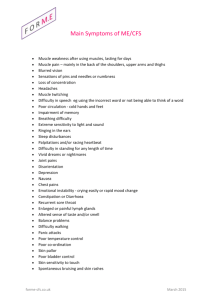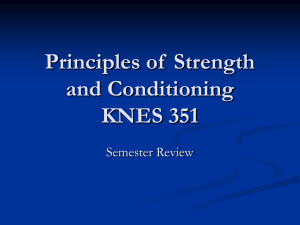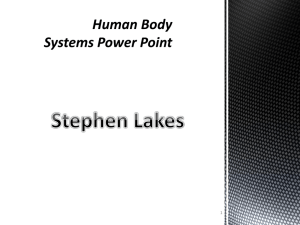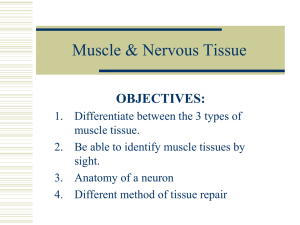Muscle strength grading
advertisement
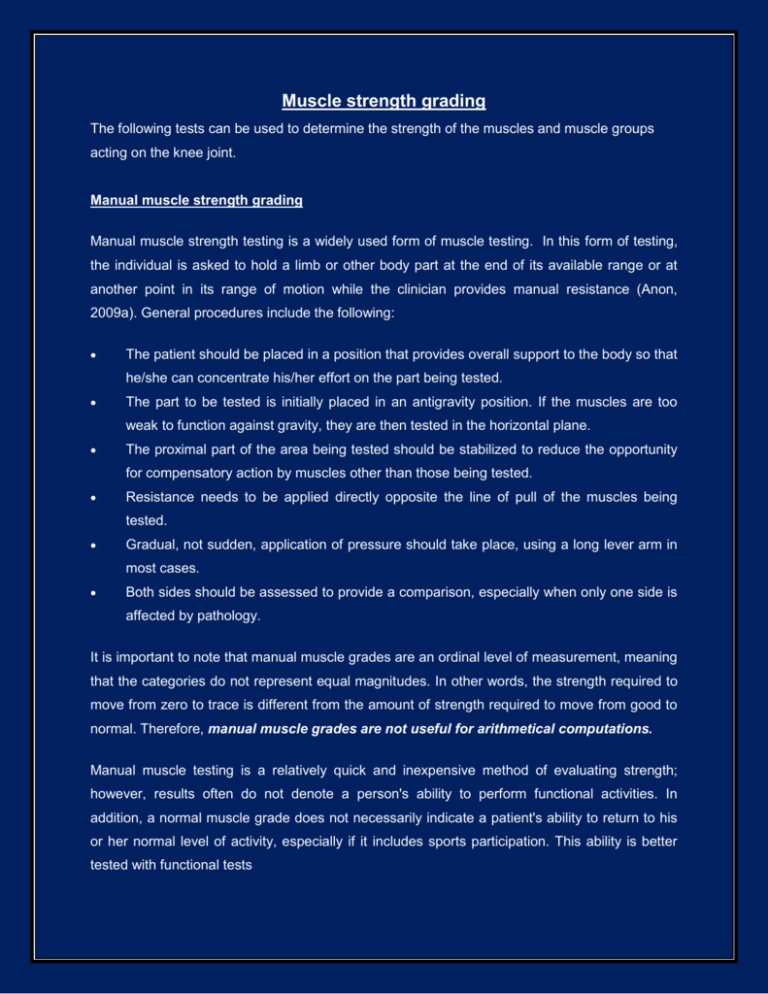
Muscle strength grading The following tests can be used to determine the strength of the muscles and muscle groups acting on the knee joint. Manual muscle strength grading Manual muscle strength testing is a widely used form of muscle testing. In this form of testing, the individual is asked to hold a limb or other body part at the end of its available range or at another point in its range of motion while the clinician provides manual resistance (Anon, 2009a). General procedures include the following: The patient should be placed in a position that provides overall support to the body so that he/she can concentrate his/her effort on the part being tested. The part to be tested is initially placed in an antigravity position. If the muscles are too weak to function against gravity, they are then tested in the horizontal plane. The proximal part of the area being tested should be stabilized to reduce the opportunity for compensatory action by muscles other than those being tested. Resistance needs to be applied directly opposite the line of pull of the muscles being tested. Gradual, not sudden, application of pressure should take place, using a long lever arm in most cases. Both sides should be assessed to provide a comparison, especially when only one side is affected by pathology. It is important to note that manual muscle grades are an ordinal level of measurement, meaning that the categories do not represent equal magnitudes. In other words, the strength required to move from zero to trace is different from the amount of strength required to move from good to normal. Therefore, manual muscle grades are not useful for arithmetical computations. Manual muscle testing is a relatively quick and inexpensive method of evaluating strength; however, results often do not denote a person's ability to perform functional activities. In addition, a normal muscle grade does not necessarily indicate a patient's ability to return to his or her normal level of activity, especially if it includes sports participation. This ability is better tested with functional tests. Grading scale for manual muscle strength testing (Prentice, 2008:61) Grade 0 Zero No evidence of muscle contraction Grade 1 Trace Evidence of slight muscle contraction with no joint motion Grade 2: Poor Complete AROM with gravity eliminated Grade 3 Fair Complete AROM against gravity with no resistance Grade 4 Good Complete AROM against gravity with some resistance Grade 5 Normal Complete AROM against gravity with maximum resistance Knee flexion The manual knee flexion strength test can be done to evaluate the strength of the hamstring muscle group and to test for any pathology in the muscle (Prentice, 2008:535). Procedure: This movement is tested with the patient lying in the supine position or with the patient prone. If the knee is flexed to 90° and the tibia is rotated externally, the greatest stress is placed on the biceps femoris with resisted knee flexion. If the tibia is rotated internally, the greatest stress is placed on the semi-membranosus and the semi-tendinosus. The examiner performs an isometric resistance while the patient performs knee flexion. The examiner will then grade the muscle strength according to the grading scale for manual muscle strength testing (Prentice, 2008:61) scale. This test is done when examining the patient. It is done as an assessment of the strength of the hamstring muscles. Knee extension The manual knee extension strength test can be done to evaluate the strength of the quadriceps muscle group (Magee, 2002:678). Procedure: This movement is tested with the patient lying in the supine position or with the patient prone. The examiner provides an isometric resistance while the patient performs a knee extension. The examiner will then grade the muscle strength according to Prentice scale. Other muscle groups can also be tested on the same principle.
